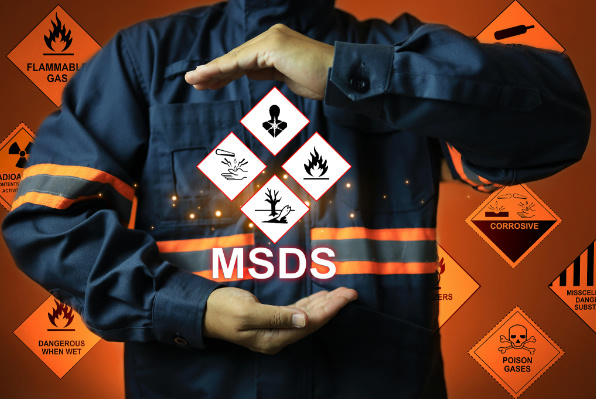Material Safety Data Sheets (MSDS): Comprehensive Guide

Introduction to MSDS
Safety Data SheetMaterial Safety Data Sheet (MSDS) is a document used by chemical manufacturers and importers to explain the physical and chemical properties of chemicals, such as pH, flashpoint, flammability, and reactivity, as well as potential health risks like carcinogenic or teratogenic effects. In Europe, MSDS is also known as Safety Data Sheet (SDS). The International Organization for Standardization (ISO) adopts the term SDS in ISO 11014, while countries like the USA, Canada, Australia, and many Asian nations use MSDS.
MSDS is a legally required document that provides detailed information on the properties, hazards, and handling of a chemical product, including safety precautions and regulatory information.
Standard MSDS Content
1. Information Required by OSHA
- Manufacturer and Contact Information
- Hazardous Chemical Components
- Physical and Chemical Properties
- Fire and Explosion Data
- Reactivity Data
- Health Hazard Data
- Safe Handling and Usage Instructions
- Protective Measures
2. WHMIS Requirements in Canada
- Product Name and Manufacturer Information
- Hazardous Chemical Components
- Physical Characteristics
- Fire and Explosion Data
- Reactivity Data
- Toxicological Properties
- Preventive Measures
- First Aid Measures
- Preparation Information
3. ANSI and ISO Recommendations
- Chemical Name and Manufacturer Information
- Chemical Composition
- Hazard Information
- First Aid Measures
- Firefighting Measures
- Accidental Release Measures
- Handling and Storage
- Exposure Controls and Personal Protection
- Physical and Chemical Properties
- Stability and Reactivity
- Toxicological Information
- Ecological Information
- Disposal Considerations
- Transport Information
- Regulatory Information
- Other Information
China’s MSDS Standards
China has adopted standards equivalent to ISO 11014-1:1994(E), outlined in GB16483-2000, which specifies the following 16 sections:
- Chemical Product and Company Identification: Includes chemical name, manufacturer details, and contact information.
- Composition/Information on Ingredients: Specifies whether the substance is pure or a mixture, along with CAS numbers for hazardous components.
- Hazards Summarization: Highlights key hazards, including health, environmental, and fire risks.
- First-Aid Measures: Provides emergency procedures for exposure incidents.
- Fire-Fighting Measures: Details fire hazards and suitable extinguishing methods.
- Accidental Release Measures: Outlines emergency response and cleanup procedures for spills.
- Handling and Storage: Lists safe handling and storage practices.
- Exposure Controls/Personal Protection: Includes protective measures and exposure limits.
- Physical and Chemical Properties: Describes the substance’s characteristics, such as pH and flashpoint.
- Stability and Reactivity: Discusses chemical stability and potential reactions.
- Toxicological Information: Covers acute and chronic toxicity data.
- Ecological Information: Details environmental impact and behavior.
- Disposal Considerations: Provides guidance on safe disposal methods.
- Transport Information: Specifies transportation requirements and classifications.
- Regulatory Information: Lists relevant legal and regulatory details.
- Other Information: Includes references, document preparation details, and review information.
MSDS Structure and Requirements
China has established GB 16483-2000 "General Rules for Preparing Chemical Safety Data Sheets" in alignment with international standard ISO 11014-1:1994(E). This regulation specifies that MSDS (Material Safety Data Sheets) should consist of 16 sections:
1. Chemical Product and Company Identification
Includes the name of the chemical, manufacturer information (name, address, postal code, telephone, emergency contact, fax, and email).
2. Composition/Information on Ingredients
Specifies whether the chemical is a pure substance or a mixture. For pure chemicals, provide the chemical name or trade name and common name. For mixtures, list the concentrations or ranges of hazardous components. Provide CAS numbers for hazardous components.
3. Hazards Summary
Summarizes key hazards and effects, including hazard categories, exposure routes, health hazards, environmental hazards, and risks of fire or explosion.
4. First-Aid Measures
Describes immediate actions for self-help or mutual aid in case of injury. Covers first-aid steps for eye contact, skin contact, inhalation, and ingestion.
5. Fire-Fighting Measures
Provides information on fire hazards, suitable extinguishing agents, unsuitable extinguishing agents, and protective measures for firefighters.
6. Accidental Release Measures
Details simple and effective on-site emergency response measures, precautions, and cleanup methods for chemical spills.
7. Handling and Storage
Outlines safe practices for handling and storing chemicals, including safety precautions during operations and storage conditions.
8. Exposure Controls/Personal Protection
Describes protective measures to prevent chemical exposure, including permissible concentration limits, engineering controls, and personal protective equipment for respiratory, eye, hand, and body protection.
9. Physical and Chemical Properties
Lists physical and chemical properties, such as appearance, pH, boiling point, melting point, density, vapor pressure, flashpoint, solubility, and other relevant characteristics.
10. Stability and Reactivity
Discusses the chemical's stability and reactivity, including stability under normal conditions, incompatible materials, and decomposition products.
11. Toxicological Information
Provides toxicological data, such as acute toxicity (LD50), irritancy, sensitization, subchronic and chronic toxicity, mutagenicity, teratogenicity, and carcinogenicity.
12. Ecological Information
Details the chemical's environmental impact, including biodegradability, bioaccumulation, environmental migration, and other harmful effects.
13. Disposal
Describes safe disposal methods for contaminated packaging and unusable chemicals, including specific disposal precautions.
14. Transport Information
Outlines domestic and international packaging and transport requirements, including hazard classification, packaging category, UN number, and transport precautions.
15. Regulatory Information
Lists relevant laws, regulations, and standards related to chemical management.
16. Other Information
Provides additional safety-related information, such as references, form completion date, responsible department, and data review unit.

